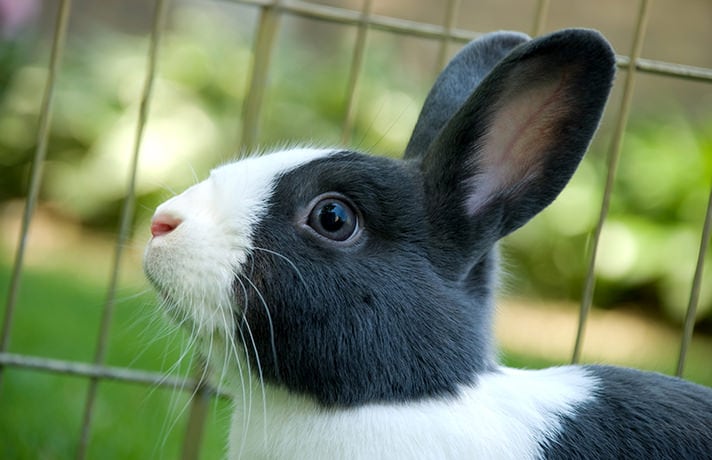Almost everyone with a pet rabbit has heard about Encephalitozoon cuniculi as a cause of head tilt or cataracts, but not many rabbit owners understand much else about the disease. Encephalitozoon cuniculi, often abbreviated as E. cuniculi or simply EC, is a eukaryotic parasite of mammals, meaning it has a distinct nucleus and other internal structures (organelles) that make it more complex than a bacterium. EC is a microsporidian, a type of organism more closely related to fungi than to protozoans or animals. A distinctive characteristic is that EC lacks functional mitochondria, the energy engine of a cell, because it lives within animal cells and gets its energy from its host cell’s mitochondria.
EC can cause significant disease in some rabbits, but they are not the only mammals that can be infected. Otherwise healthy guinea pigs and mice are important reservoirs of EC and can spread it to rabbits. There are at least three different strains of EC, each of which seems to prefer a different host. EC infection has been documented in many other mammals across the world, including wild mammals, cats, horses and people, but appears to cause severe illness only in immunocompromised hosts. EC spreads by its infective spores contaminating the environment. The spores are shed in urine and occasionally feces, and from there are easily spread throughout the rabbit’s home environment. EC spores can stay infective for months in cool, humid environments and have been known to survive for at least a month under dry conditions at comfortable room temperatures. Rabbits may acquire the disease from ingesting the spores, inhaling the spores or spores settling on their eyes, and infected does can pass it on to their unborn babies.
Signs Of E. Cuniculi
When EC infects the eyes or nervous system, the signs may be obvious, such as a head tilt (vestibular disease) or cloudy eyes (inflammation of the fluid between the cornea and the lens, also known an anterior uveitis) or cloudy lenses of the eyes (cataracts). A confirmed diagnosis of EC can be elusive, because other conditions can cause similar problems and the diagnostic tests can be expensive. Sometimes a rabbit may have lifelong EC infection of the kidneys and otherwise appear healthy, with all detectable physiological parameters of kidney function staying within normal limits. Even at death the kidneys may appear perfectly normal to even an experienced pathologist, because the changes caused by the microsporidian may be subtle. It may take specialized diagnostic tests, such as polymerase chain reaction (PCR) studies, to detect EC DNA and confirm the infection. From laboratory studies, we know EC infects a rabbit’s lungs, liver and kidneys within about a month of exposure. Within about this same time, EC lesions may develop in the brain and eye. If a rabbit successfully fights the infection, you may never see any indication he contracted EC. However, if the rabbit’s immune system is not successful, or sometimes if the rabbit’s immune system is overly aggressive, the inflammation associated with EC gets more extensive. If this happens in the part of the brain that controls head posture and balance, it causes one of the conditions most often recognized by pet owners, a head tilt. Similarly, a uveitis or a cataract may develop in one or both eyes. Sometimes the inflammatory lesions of EC affect areas of the brain or nerves through the body that cause more subtle signs, such as difficulty chewing or inhaling rabbit food during eating, or sometimes a change in how a rabbit holds his legs. Some rabbits may develop paralysis or weakness of the hind legs. Others may dribble urine as the nerves affecting bladder control are affected. If the disease is not treated, or fails to respond to treatment, a rabbit may worsen and start to roll uncontrollably and seizure. If it has only noticeably affected the eyes, the cataracts may mature and completely blind the rabbit. With enough time, the eye lenses may actually rupture from the infection and suddenly cause severe inflammation causing excessive tears, redness and swelling. There are EC-infected rabbits whose only outward signs are vague. You might think something is wrong but can’t quite describe what it is. Other EC-infected rabbits may have poor appetite, weight loss or lethargy. In some cases, the heart may be damaged from the EC-infection causing a reluctance to exercise, rapid breathing when he does hop around, and spending a lot of time resting or sleeping. The variety of signs that EC can cause in a rabbit is why EC should always be considered by a veterinarian examining an ill rabbit and why a diagnostic test for EC may be offered as part of the diagnostic evaluation of an ill rabbit.
Diagnosing E. Cuniculi
Veterinarians usually suspect EC based on subtle-to-unmistakable changes in the eyes, posture, movements or other neurological abnormalities. A PCR swab of urine and feces may find the DNA of EC, which confirms that a pet has spores, but many EC-infected rabbits do not shed these spores continuously. A better diagnostic test involves submitting a blood sample for two different evaluations: an ELISA titer, which measures levels of antibodies to EC, and protein electrophoresis, which assesses the types of proteins in the rabbit’s blood. The ELISA test indicates if a rabbit has been exposed to EC, while the protein electrophoresis may differentiate between active disease or a past illness from which the rabbit recovered. A computed tomography scan (CT) or magnetic resonance imaging (MRI) may detect brain lesions. While these imaging tests can’t confirm EC as the cause of the lesions, the location and size of the brain lesions can suggest whether a rabbit is likely to improve or have permanent neurological problems. The downsides are that these imaging tests require the rabbit to be anesthetized, are quite expensive and may miss miniscule lesions that nevertheless cause profound changes in the rabbit’s behavior and health. Additionally, comparatively little work has been done to map normal rabbit brain anatomy using these techniques, which can confound interpreting the images obtained from an ill rabbit.
By: Kevin Wright, DVM, DABVPThis article was originally published in the 2012 issue of Rabbits USA magazine.
More on Rabbit Diseases and Conditions
Share:









